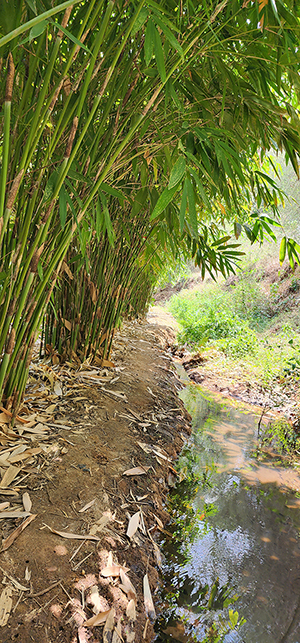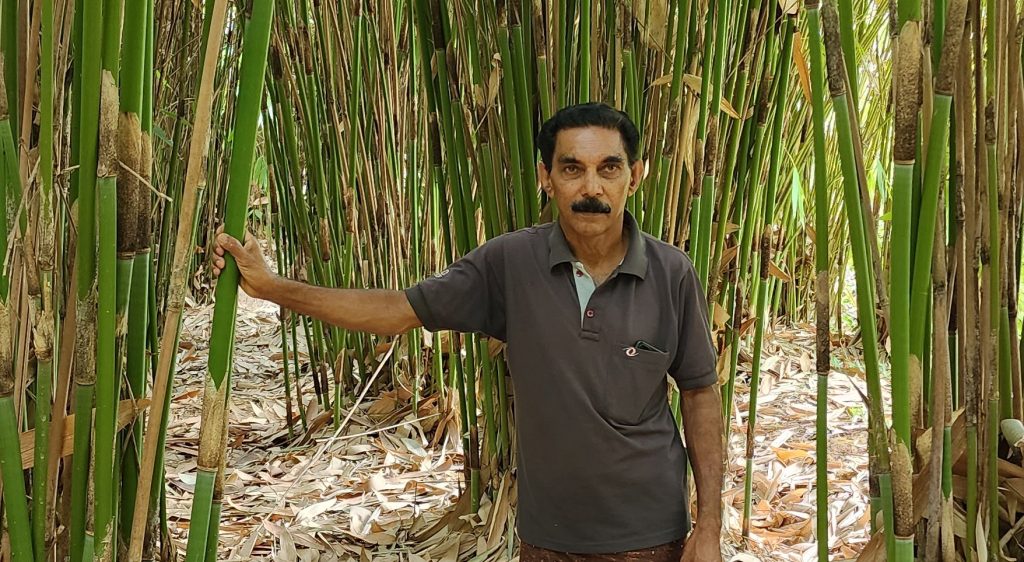
A sustainable model to check the encroaching desertification tendencies of southern Deccan plateau to the district, farming with Bamboo could be an ideal and effective method. A model developed in 3.5 acres in the Pulpally region by a farmer Mr. Bhaskaran sets a live example for the protection of water, soil resources and also for the conservation of biodiversity. Since the Pulpally region of the district is facing pertinent threat by the changing climatic conditions, drying up of water resources is very common. In addition, crop raids by wild animals due to the resource depletion in the forest is also rampant. Predicament of the farmers in this region of the district is scary, farming is considered as a nightmare and many a farmers either quit farming or find alternate income generation methods such as business or micro enterprises.
Farming with Bamboo
Mr. Bhaskaran, an innovative farmer from Madaparamba, Pulpally has changed the micro climatic condition of the Madaparamba region of Pulpally by planting selected species of Bamboo. Farming with Bamboos not only protects the natural resources but it also contributes to mitigating the adverse effects of climate change. The stream that earlier dried up in the month of Nov-Dec could give water till the start of next monsoon in June says Mr. Bhaskaran. The moisture content of the soil has become rich, the water retention capacity of the soil increased and the organic carbon in the soil has increased, he added. In addition to that, the biodiversity especially the bird diversity in the Bamboo arboretum is pretty rich and around 20 different types of birds can be observed in the garden and many of them make nest in the garden as well, he added.
Bamboo Farming To Keep The Dessertification At Bay: Case Study
Preventing the Entry of Wild Animals
An important benefit of farming with Bamboo is that it can help prevent the entry of wild animals to the farm. ‘Even the most ferocious elephants couldn’t yield from this garden by eating the Bamboo’, says Mr. Unni, son of Mr. Bhaskaran. Since the fibre content in this species of Bamboo is more, the elephants couldn’t break it and after trying for a few minutes they will go away, he added. Other wild animals that are rampant in the area such as wild boar and deer couldn’t find any eatables from the garden and they are also avoiding the garden, Mr. Unni added.

Support of Departments
Guidance and assistance of District soil conservation department was crucial in establishing this garden at Pulpally. The department not only provided the technical expertise but also given the necessary planting material to the farmer to set up a model garden for soil and water conservation. ‘The micro climatic condition that formed inside the arboretum is so unique and the biodiversity composition including the soil micro biome has changed positively in the garden’, says Mr. P.U. Das, former District Soil Conservation Officer, Wayanad. Since the root system of the Bamboo can protect and cover huge mass of soil the erosion of soil due to torrential rain falls and floods can also be prevented, he added. In addition to the support from department, Pulpally Grama Panchayath also supported in planting of the seedlings in the garden.
Cost of cultivation
A total of 400 numbers of bamboos can be planted in an acre of land and its maintenance & management cost is quite economical. Channel making and water outlets to drain out excess amount of water is the activity to be taken care of in every garden without which the seedlings would be damaged. One kilo gram of Bamboo can be sold for a price of Rs. 6; so farmers especially those who have swamps and marshy lands where no other cultivation would be possible can easily cultivate Bamboos and generate income. Since the Bamboos are one of the fast growing plant species it can easily alter the existing condition and can also assimilate larger quantities of atmospheric carbon dioxide. The yield will significantly increase if it is provided with chemical fertilizers and other plant growth promoting practices.
Replication Possibilities
As a low-cost method of carbon sequestration, conservation of natural resources and protection of biodiversity of the region; farming with Bamboo could be considered as an ideal and efficient method to mitigate the adverse effects of climate change. Technology involved in developing a Bamboo arboretum is pretty simple and easy to follow with the support of Grama Panchayath, Forest department and other helping hands.
